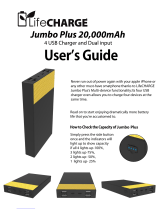
©Copyright Task Force Tips LLC 2014-2022 20 LIA-208 July 25, 2022 Rev06
8.0 MAINTENANCE
TFT products are designed and manufactured to be damage resistant and require minimal maintenance. However, as the primary
firefighting tool upon which your life depends, it should be treated accordingly. The unit should be kept clean and free of dirt by rinsing
with water after each use. Any inoperable or damaged parts should be repaired or replaced before placing the unit in service. To help
prevent mechanical damage, do not drop or throw equipment.
In applications where appliances are left continuously connected to the apparatus or other devices or are used where water is trapped
inside the appliance, the appliance must be flushed with fresh water following each use and inspected for damage.
This appliance should be disconnected, cleaned and visually inspected inside and out at least quarterly, or as water quality and use may
require. Moving parts such as handles, valve ball and couplings should be checked for smooth and free operation. Seals shall be
greased as needed with Silicone based grease such as Molykote 112. Any scrapes that expose bare aluminum should be cleaned and
touched up with enamel paint such as Rust-Oleum. Replace any missing or damaged parts before returning to service.
Any equipment taken out of service due to failure should be returned to the factory for repair or replacement. If you have any questions
regarding the testing or maintenance of your valve, please call Task Force Tips at 800-348-2686.
8.1 TROUBLESHOOTING
Table 8.1
8.2 SERVICE TESTING
In accordance with NFPA 1962, equipment must be tested a minimum of annually. Units failing any part of this test must be removed
from service, repaired and retested upon completion of the repair.
8.3 REPAIR
Factory service is available. Factory serviced equipment is repaired by experienced technicians, wet tested to original specifications,
and promptly returned. Call TFT service department at 1-800-348-2686 to troubleshoot and, if needed, directions for return. A return for
service form can also be obtained at tft.com/Support/Returning-an-Item-for-Service.
Repair parts and service procedures are available for those wishing to perform their own repairs. Task Force Tips assumes no liability for
damage to equipment or injury to personnel that is a result of user service. Contact the factory or visit the web site at tft.com for parts
lists, exploded views, test procedures and troubleshooting guides.
Performance tests shall be conducted on the equipment after a repair, or anytime a problem is reported to verify operation in accordance
with TFT test procedures. Consult factory for the procedure that corresponds to the model and serial number of the equipment. Any
equipment which fails the related test criteria should be removed from service immediately. Troubleshooting guides are available with
each test procedure or equipment can be returned to the factory for service and testing.
SYMPTOM POSSIBLE CAUSE REMEDY
Leaks Debris or damage in seal area Clean out debris and/or replace damaged parts
Binding, Erratic Operation Low voltage (see below) See Below
Power LED on but no operation Low voltage due to:
• wire gauge too small
• wire length too long
• poor connection
• inadequate apparatus electrical
system
Check connections and wiring See Section 5.3.1
on page 14.
LED D6 on motor board blinks
rapidly when button is pressed
Loose encoder connection Replace motor subassembly
Bad motor encoder Replace motor subassembly
No power LED Polarity reversed or poor connection Check wiring and correct polarity
OPEN & CLOSE LED blink every 4
seconds
No communication with Valve Motor Check Blue and White communication wiring
It is the responsibility of service technicians to ensure the use of appropriate protective clothing
and equipment. The chosen protective clothing and equipment must provide protection from
potential hazards users may encounter while servicing equipment. Requirements for protective
clothing and equipment are determined by the Authority Having Jurisdiction (AHJ).
CAUTION Any alterations to the product or its markings could diminish safety and constitutes a misuse of
this product.
All replacement parts must be obtained from the manufacturer to assure proper performance and
operation of the device.




















